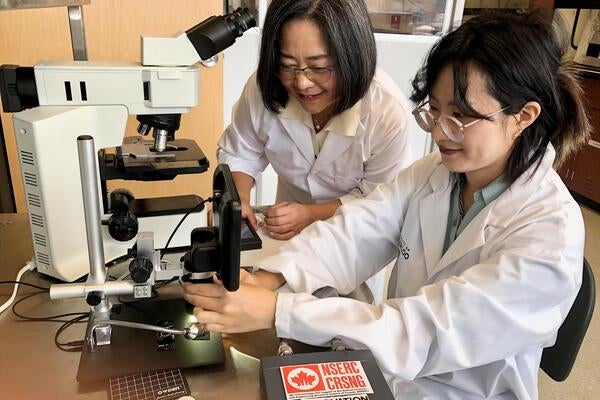
Using 3D imaging to transform plastic waste recycling
Researchers are now able to observe the degradation of micro and nanoplastics with unprecedented detail

Researchers are now able to observe the degradation of micro and nanoplastics with unprecedented detail
By Media RelationsIn a global first, University of Waterloo researchers have used 3D imaging technology to understand the fine details of microplastics, paving the way for more effective methods of plastic waste recycling.
Micro and nanoplastics, tiny particles of plastic that come from the breakdown of larger plastic items, have become an exponentially worsening environmental crisis. Due to their difficulties in safely decomposing, plastic pollution poses significant threats to ecosystems, wildlife and human health.
Scientists have struggled to understand the exact process of how these micro and nanoplastics degrade, particularly at the micro and nanoscale, which has hampered efforts to mitigate their environmental impact. Observing and understanding how the fine details of microplastics function and how they break down are key to eradicating them from our environment.
In collaboration with the National Research Council (NRC), researchers leveraged 3D imaging technology in addition to traditional 2D microscopy, allowing them to observe the degradation of micro and nanoplastics with unprecedented detail.
"Most microscope images provide a two-dimensional view, similar to a medical X-ray, which gives us some information but lacks depth," said William Anderson, a professor in Waterloo’s Department of Chemical Engineering.
"However, 3D imaging is like a CT scan, offering far more detailed insights into the structure and degradation of microplastics. This level of detail has been incredibly challenging to achieve, but it's crucial for understanding what is happening at the surface of micro and nanoplastics and how degradation processes work."
The research group used a novel combination of physical and biological approaches to obtain their new visual data. They utilized a photocatalytic process, which treated micro and nanoplastics with UV light and a titanium oxide catalyst. As a result, the team could observe and analyze the degradation at a microscopic level.
"Using this methodology reveals not just that degradation is happening, but exactly how and where it's occurring on the surface of micro and nanoplastics, said chemical engineering professor Boxin Zhao, a University of Waterloo Endowed Chair in Nanotechnology. “This knowledge is crucial for developing more effective methods of breaking down plastics on the micro and nanoscales.”
Anderson and Zhao, in collaboration with researchers from the Department of Chemical Engineering and the Department of Biology at Waterloo, are developing biocycling methods where microplastics could be used as a carbon source for bacteria. These bacteria would ingest microplastics and then excrete an environmentally friendly biopolymer that could be used to create new materials like plastic bags or packaging films.
This study has broader implications for Waterloo’s research team, which is now forming a multidisciplinary plastics biocycling research initiative.
The collaboration underscores the importance of bringing together different fields of expertise to tackle complex environmental challenges. This research offers valuable insights that could pave the way for more effective methods of plastic waste recycling and contribute to a circular economy.
The study, “3D imaging photocatalytically degraded micro-and nanoplastics”, was recently published in IOPSCIENCE.

Read more
New Canada Research Chairs will tackle future-focused problems from social robots and intergroup attitudes to geochemistry and nanoscale devices

Read more
Twenty-six researchers receive federal funding to drive discovery, innovation and research infrastructure development

Dr. Carolyn Ren (left) works with new technology to detect E. coli bacteria in water with PhD student Qianying (Alice) Mao in her lab at the University of Waterloo.
Read more
Waterloo researchers develop inexpensive technology to help prevent deaths, illness caused by contaminated water
The University of Waterloo acknowledges that much of our work takes place on the traditional territory of the Neutral, Anishinaabeg, and Haudenosaunee peoples. Our main campus is situated on the Haldimand Tract, the land granted to the Six Nations that includes six miles on each side of the Grand River. Our active work toward reconciliation takes place across our campuses through research, learning, teaching, and community building, and is co-ordinated within the Office of Indigenous Relations.